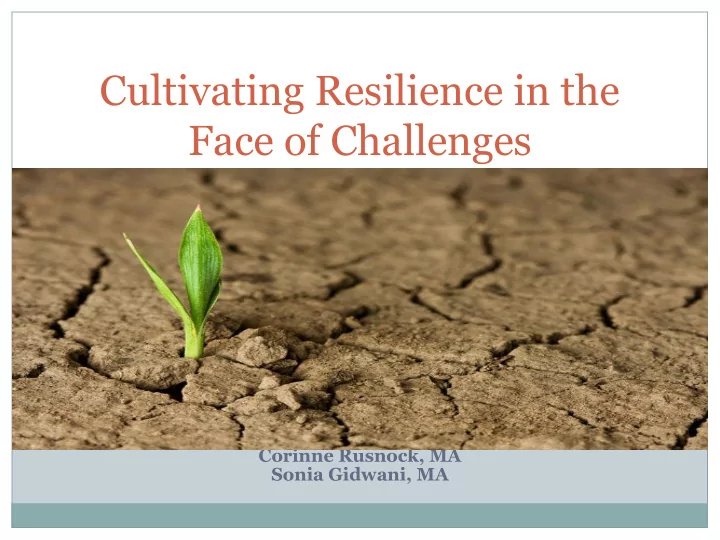

Cultivating Resilience in the Face of Challenges Corinne Rusnock, MA Sonia Gidwani, MA
Bouncing Back Vs. Bouncing Forward Can You Go Back? Will Life Ever Be the Same? Resiliency is: ● The ability to function competently in the face of adversity or stress. ● Adolescent and child stress can come from multiple directions: ○ School ○ Relationships issues ○ Peer pressure ○ Poverty/Family financial strain ○ Decisions about college/careers ○ Health issues Resiliency is being able to ● bounce back.
American Psychological Association (2018) Trauma Informed Care The Road to Resilience Research indicates that resiliency is ordinary, not extraordinary, people commonly demonstrate that they are resilient.
The Road to Resilience Resilience can be cultivated in children and adolescents by teaching behaviors and skills that promote positive mental health.It is not something that one child is born with and another child is born without. Genetic temperaments may impact how a child manages stressors or stressful circumstances, however; has no impact on resilience or the ability to develop of resilient traits.
Characteristics of Resilient Youth
Characteristics of Resilient Youth ● Relationships with caring adults Youth feel more supported, are more socially expressive, and are less likely to be depressed. ○ ● Relationship skills/social competence This is the ability to apply problem-solving skills to interpersonal problems or conflicts, to ○ show empathy for the feelings of others, and voluntarily helping others in need. It is the ability to be emotionally close to others. ■ Social skills can be taught. Emotional self-regulation ● ○ Youth’s ability to manage their emotions (ie: Emotional Intelligence) Anger Management ■ ■ Impulse control Cognitive skills ● ○ Intelligence, good judgement, and problem-solving skills. Intellectual abilities may make it easier for some adolescents to generate multiple, or more ○ effective, solutions to problems.
Characteristics of Resilient Youth ● Confidence & “inner-directedness”: Resilient youth tend are more likely to have an internal locus of control and ○ inner-directedness. Internal Locus of Control: belief in oneself and one’s powers or abilities (Confidence). ■ ■ Inner-directedness: ability to trust one’s own decisions and being able to act on them. Youth do not see themselves as passive recipients of fate, and believe that they are able to have ○ influence over outcomes. ● Talents/ Skills/Healthy leisure activities ○ Having one or more activities that the youth identifies as being able to do well, takes pride in, or enjoys sharing with others. ■ ie: hobbies, athletics, performing arts, computer technology, volunteerism, etc… ● Religion/Spirituality ○ Memberships in religious organizations and be additional sources of social supports and caring relationships.
Characteristics of Resilient Youth ● Resilient youth tend to be less likely to engage in risky behaviors, such as violence, substance use, and teenage pregnancy, than other adolescents. ● Resilient youth tend to engage is healthy self-care activities to aid in the reduction of regular stress on their lives (ie: exercise, practicing relaxation techniques, engaging in healthy leisure activities).
Modeling a Resiliency Attitude To Youth ⚫ A “resiliency attitude”: ⚪ shows caring, support and validation to the child while focusing on the child’s ability to overcome the problem. ⚪ Verbally and non - verbally communicates the message that you see a child’s positive characteristics and strengths despite past behavior and current problems. ⚪ Focuses on strengths the same or even more than weaknesses. ⚪ Nurtures a child’s positive self view. Henderson, Nan (2007) “Resiliency in Action: Practical Ideas for Overcoming Risk and Building Strengths in Youth, Families & Communities”
Building Blocks of Resilience: How Do Adults Lay The Foundation for Youth? Connection Foster connection for children by: ⚫ creating physical and emotional security ⚫ understanding developmental phase’s children go through and their social needs at each phase ⚫ fostering healthy relationships outside of the family (sports, groups, trusted adults)
Building Blocks of Resilience Competence ⚫ Focus on child’s strengths in each area of competencies: ⚪ cognitive (decision making, problem solving), ⚪ emotional (self regulation) ⚪ moral (positive self perceptions), ⚪ behavioral (talents), ⚪ social (appeal to others) ⚫ Empower child to make their own decisions and to make safe mistakes.
Building Blocks of Resilience Confidence Increase a child’s confidence by: ⚫ recognizing /praising good qualities, achievements ⚫ catching child being kind, helpful ⚫ focusing on what child has done correctly, not mistakes that were made along the way ⚫ supporting child when a failure or disappointment occurs, validating feelings ⚫ making expectations clear and age appropriate
Building Blocks of Resilience Character ⚫ Build character in youth by: ⚪ helping child to see the impact of their behavior/choices on others ⚪ allowing child to consider right vs. wrong ⚪ clarify their own values ⚪ demonstrating the importance of community ⚪ helping child to see him/herself as a caring person
Building Blocks of Resilience Contribution ⚫ Instill the concept of contribution in children by: ⚪ modeling generosity and service ⚪ communicating belief that child can help others ⚪ creating opportunities for child to contribute or demonstrate care to others
Building Blocks of Resilience Coping ⚫ Help children to discern a crisis vs. what feels like a crisis ⚫ Model positive coping skills on a consistent basis ⚫ Guide child to develop effective coping strategies ⚪ build off of their existing interests/likes ⚫ Model problem solving step by step ⚫ Model self care ⚪ exercise ⚪ nutrition ⚪ good sleep practices
Building Blocks of Resilience Control ⚫ Give children the opportunity to make decisions on an age appropriate level. ⚫ Help children to ⚪ recognize that their decisions can create or influence outcomes ⚪ celebrate their successes, even small ones
Questions/Comments
References Murphey, David, Barry, Megan, and Vaughn, Brigitte (2013) Positive Mental Health: Resilience. Child Trends, Publication #2013-3. “The 7 Cs: The Essential Building Blocks of Resilience.” Fostering Resilience , www.fosteringresilience.com. Henderson, Nan (2007) “Resiliency in Action: Practical Ideas for Overcoming Risk and Building Strengths in Youth, Families & Communities”
Recommend
More recommend